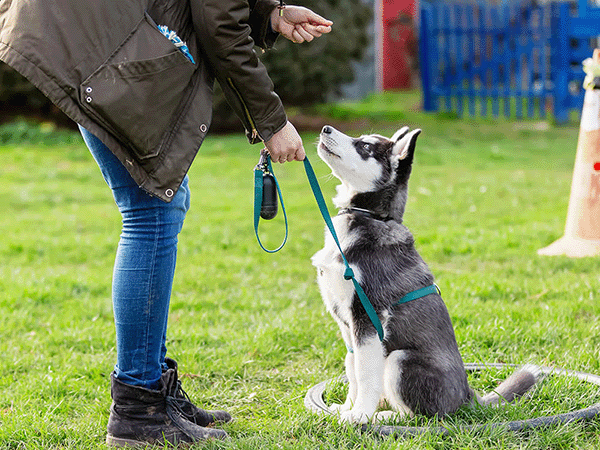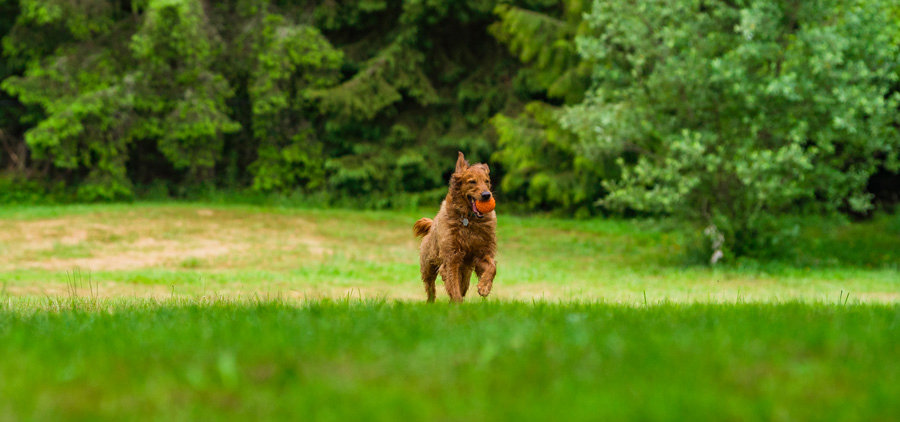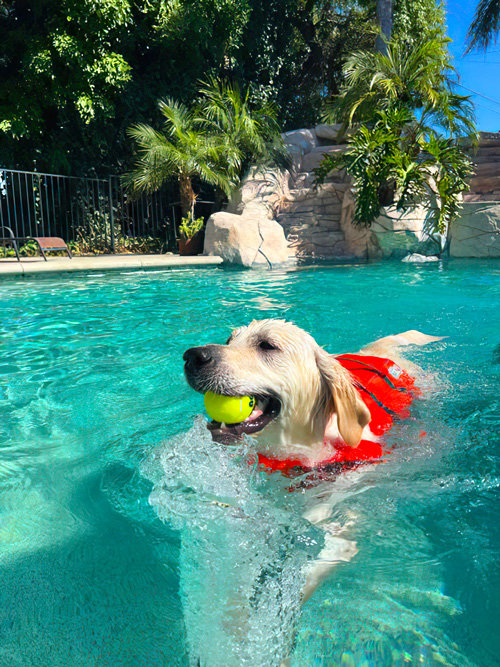American Airlines Pet Policy: A Simple Guide for Dog Owners

Flying with your dog on American Airlines? Understanding their pet policy is key to a smooth trip. This guide covers everything about the American Airlines pet policy, from carrier requirements and fees to tips from seasoned pet travelers in the Sniffspot community. Let's make sure your trip is paw-sitive from start to finish.
After analyzing American Airlines’ latest pet travel requirements and gathering insights from our pet-loving community, we’ve created this comprehensive guide to help you and your furry friend take to the skies with confidence.
American Airlines Dog Policy: What You Need to Know
- Quick Stats: Dog Travel Today
- Quick Overview: American Airlines Dog Travel Options
- Why Do Pet Owners Choose American Airlines for Dog Travel?
- American Airlines Dog Policy for Carry On Pets
- American Airlines Size and Carrier Requirements
- American Airlines Carry-On Pet Policy: Important Restrictions
- Fees and Booking Process
- American Airlines Dog Policy for Checked Pets
- American Airlines Checked Pet Documentation Needed
- American Airlines Checked Pet Booking Process
- American Airlines Checked Pet Carrier Requirements
- Temperature Restrictions for Pet Travel on American Airlines
- American Airlines PetEmbark®: Cargo Travel for Pets
- American Airlines Dog-Friendly Destination Restrictions
- Flying with Larger Dogs
- Tips for Flying Your Dog on American Airlines (From Real Pet Parents!)
- Frequently Asked Questions: Everything You Ever Wanted to Know About Flying with Dogs on American Airlines
Key Takeaways
- American Airlines caters to different pet travel needs: In-cabin travel works for small dogs, while active military personnel on official orders can utilize checked baggage travel. PetEmbark cargo shipping is also an option, currently limited to military personnel. Factor in your dog's size, temperament, and the specific requirements of each option.
- Pre-flight prep is key for a smooth journey: Book your pet's travel early, understand American Airlines' carrier and kennel rules, and get to the airport with plenty of time to spare. A tired, crate-trained dog is a happy flying dog.
- Sniffspot simplifies dog-friendly travel planning: Find the perfect parks, water parks, and other tail-wagging activities at your destination using Sniffspot. Let your dog stretch their legs and enjoy some off-leash freedom after their flight.
Understanding American Airlines' Pet Policy Options
In-Cabin Travel vs. Checked Baggage vs. PetEmbark Cargo
American Airlines offers a few different ways to travel with your pet, depending on their size and your specific needs. Small cats and dogs can travel in the cabin, while larger animals typically need to travel via cargo. Let's break down each option:
- In-Cabin Travel: If your furry friend (including their carrier) weighs under 20 pounds, they can fly in the cabin with you. This is generally the preferred option for most pet owners, as it allows you to keep your dog close and monitor them throughout the flight. Keep in mind that there's a fee of $150 each way for in-cabin pets. You'll also need to make sure your carrier meets American Airlines' specific size requirements, which we'll cover later in this guide.
- Checked Baggage: Currently, checked baggage for pets is exclusively available to active-duty U.S. military and State Department personnel traveling on official orders. The fee is $200 per kennel. If this applies to you, be sure to check with American Airlines directly for the most up-to-date information and specific requirements.
- PetEmbark Cargo: For larger dogs, or those who don't meet the requirements for in-cabin travel, American Airlines offers PetEmbark®, their dedicated cargo service for animals. However, it's important to note that this service is currently unavailable except for active US military personnel. There are also restrictions based on age, breed, and the health of your pet. If you're considering this option when it becomes available, contact American Airlines directly to discuss your dog's specific needs and ensure they meet the eligibility criteria.
Which Option Is Right for Your Dog?
Choosing the right travel option for your dog depends on several factors. Your dog's size and weight are key considerations, as in-cabin travel has strict limits. If your dog is too large for in-cabin travel, and you're not active military personnel, your options are currently limited as American Airlines' cargo service for pets is temporarily unavailable for the general public.
Your dog's temperament matters too. If your dog is anxious or reactive—like many are (our Sniffspot survey showed 68% of dog owners have reactive dogs!)—the stress of air travel can be especially challenging. Weigh the potential risks and benefits of each travel option. If possible, in-cabin travel might be less stressful, as it allows you to comfort and reassure your dog throughout the flight.
Finally, remember that temperature restrictions apply to all forms of pet travel on American Airlines. No pets are allowed to fly if the temperature is expected to exceed 85°F (29.4°C) or fall below 45°F (7.2°C) at any point during the journey. This is a crucial safety measure. Many pet owners appreciate American Airlines' commitment to pet safety, which includes their clear policies and accommodating staff.
Quick Stats: Dog Travel Today
Our latest user dog-friendly travel survey shows:
- Frequently travelers: 32.8% of dog owners travel frequently or very frequently with their dogs
- Difficult planning: 48% find traveling with dogs “somewhat more difficult” than traveling without, and 40% find it “much more difficult”
- Flight search: 22% cite accommodation and flying as their biggest challenges when traveling with dogs
Quick Overview: American Airlines Dog Travel Options
Before we dig into the bones of the policy, here are the three main ways your dog can travel on American Airlines:
- Carry-on Pet: Small dogs that can fit in a carrier under the seat
- Checked Pet: Limited to active-duty U.S. Military and State Department personnel
- Cargo: Through American Airlines Cargo service (recommended for larger dogs)
Want to learn more about other airlines’ pet policies? Check out our complete guide to airline dog policies in 2024 or our specific guide for flying with large dogs. For a quick breakdown on how American Airlines compares to other airlines, see the quick breakdown below:
 Source: Airline Travel Policies
Source: Airline Travel PoliciesWhy Fly Your Dog on American Airlines?
According to our 2024 Sniffspot Travel Survey, American Airlines stands out as a popular choice for pet parents. Let’s dig into what makes them a tail-wagging choice for dog travel.
 Source: Sniffspot Travel Survey 2024
Source: Sniffspot Travel Survey 2024Safety First Approach
Many pet parents in our survey emphasized American’s commitment to pet safety. “They have good safety measures in place,” notes Kathy S., while another traveler shared, “I feel my dog is the safest with AA.” This focus on safety extends from check-in through arrival, with staff and flight attendants trained to handle pet travelers with extra care.
- “They’re extra careful with my dog and make the process easier. The flight attendants really put me at ease on the flight as well!” (Jen V.)
- “Very understanding and good at being on time so they don’t rush the dogs.” (Charlotte H.)
Pet-Friendly Facilities
American Airlines has invested in making their terminals more pet-friendly, which our survey respondents particularly appreciate:
- “They make it easy to travel with dogs, and many of their terminals provide doggy potty areas.” (Canine Higher Learning)
- “They have dog-specific areas in airports, and the flight attendants were so helpful.” (Eloradan)
Accommodating Staff
The human element makes a big difference – our survey found that helpful, understanding staff was a major factor in choosing American Airlines:
- “Excellent care, friendly staff who seem to care about my dog’s well-being.” (Sara E.)
- “The forms were easy to fill out and the staff were very nice.” (Clever Pets Co.)
- “They make you feel at home.” (Lily F.)
Cabin Comfort
For those traveling with in-cabin pets, American Airlines offers practical advantages:
- “Usually has more leg room for Bowser to fit comfortably under the seat in their carrier.” (Alyssa P.)
- “They accept brachycephalic pets, and mine can go in cabin.” (Sara F.)
- “More flexible with regulations compared to other airlines nowadays.” (Emma C.)
Clear Policies
Pet parents appreciate American Airlines’ straightforward approach to pet travel:
- “They have great policies!” (Nora R.)
- “The process is clear and booking is easy.” (Andi M.)
- “Never any hassle with my service dog on American.” (P.)
- “It’s easy to fly with my psychiatric service dog with American.” (Cindy)
Consistency Across Routes
For frequent travelers, American’s extensive network and consistent pet policies make planning easier:
- “They allow dogs on many flights, unlike other airlines like JetBlue and Southwest.” (Emma T.)
- “Most common near me and consistent with their service.” (Strahan S.)
- “Used them for years with great service!” (Jarrod W.)
 Source: American Airlines Travel Policies
Source: American Airlines Travel PoliciesAmerican Airlines Dog Policy for Carry On Pets
According to our survey, 47% of our community’s dogs are medium-sized and 41% are large, making carrier requirements especially important to understand. Here’s what you need to know when it comes to American Airlines carry-on pet requirements.
American Airlines Size and Carrier Requirements
- Under the seat: Your pup must be small enough to fit comfortably in a carrier that fits under the seat. Pet carriers need to meet airline regulation size.
- Dimensions: Carrier dimensions for mainline flights vary depending on the material of your pet-friendly carrier: Hard-sided: 19″ x 13″ x 9″, Soft-sided (recommended): 18″ x 11″ x 11″. Check the latest regulation size of all pet carriers before choosing one.
Pro tip: Soft-sided carriers give you a bit more flexibility while still keeping your pup safe and comfy! Our community says it best:
- “Make sure to have a crash-tested kennel and always be prepared to change plans if they need it, bringing familiar things with me to help them feel more comfortable in travel spaces.” (Kristin O.)
- “Make sure to plan your route with good places to stop for potty breaks when driving. For airlines, soft-sided collapsible carriers are preferred.” (Laura C.)
Carrier Types and Dimensions
Your pup must be small enough to fit comfortably in a carrier that fits under the seat in front of you. Pet carriers need to meet American Airlines' size regulations. Dimensions vary depending on the material of your carrier:
- Hard-sided: 19″ x 13″ x 9″
- Soft-sided (recommended): 18″ x 11″ x 11″
Soft-sided carriers offer a little more flexibility. Always double check the latest carrier size regulations on the American Airlines website before you buy one.
Pet Weight Limits
American Airlines allows small dogs and cats weighing under 20 pounds (including the carrier) to travel in the cabin. There’s a $150 fee each way, per pet carrier. Larger animals must travel via American Airlines Cargo (currently only available for active US military personnel).
American Airlines Carry-On Pet Policy: Important Restrictions
- Limited to 5-7 kennels per flight depending on the aircraft
- No carry-on pets in First/Business on many aircrafts
- Combined weight of pet and carrier can’t exceed 20 lbs when flying First/Business on permitted flight
- Only one additional item allowed (either a personal item or carry-on bag)
Fees and Booking Process
Starting February 20, 2024, the carry-on pet fee is $150 each way. Here’s how to add your pet to your reservation:
- Book your flight on aa.com or the American app
- Go to Special Services section
- Select ‘Add carry-on pets’
- Review and accept pet requirements
- Select applicable flights
- Pay the fee at the airport check-in counter
 @Josie_The_Jack_Russel on Instagram: “Paws up, wheels up!”
@Josie_The_Jack_Russel on Instagram: “Paws up, wheels up!”How to Book Your Pet's Travel on American Airlines
Booking your pet's travel on American Airlines is pretty straightforward, but knowing the latest fees and requirements is key. As of February 20, 2024, the carry-on pet fee is $150 each way. Here’s how to add your pet to your American Airlines flight reservation:
- Book your flight: Head to aa.com or use the American Airlines app to book your own flight first.
- Find Special Services: Locate the “Special Services” section on the website or in the app.
- Add Carry-On Pets: Select “Add carry-on pets.”
- Review and Accept: Carefully review and accept all pet requirements.
- Select Flights: Choose the specific flights for your pet's journey.
- Pay at the Airport: The pet fee is paid at the airport check-in counter.
Following these steps helps ensure a smooth airport experience for both you and your furry friend. American Airlines allows small dogs that fit comfortably in a carrier under the seat. Double check that your carrier meets their size requirements: hard-sided carriers should be 19″ x 13″ x 9″, while soft-sided carriers (often recommended for a little extra space) should be 18″ x 11″ x 11″. Need help choosing a carrier? Our guide to the best dog carriers for travel can help.
For more details on American Airlines' pet policies, see these helpful resources:
- Sniffspot's Guide to American Airlines Dog Policy for Carry-On Pets
- CBS News article on American Airlines' revised pet and baggage policy
- CertaPet's Complete Guide to American Airlines Pet Policy
American Airlines Dog Policy for Checked Pets
Unfortunately, most travelers can’t check their pets on American Airlines. This service is exclusively reserved for active-duty U.S. Military and U.S. State Department Foreign Service personnel traveling on official orders. Here’s everything you need to know if you qualify:
American Airlines Checked Pet Requirements
- Must be active-duty U.S. Military or U.S. State Department Foreign Service personnel
- Must be traveling on official orders
- Maximum of 2 checked pets allowed per flight
- Fee: $200 per kennel ($150 to/from Brazil)
- Pets must meet minimum age and health requirements for destination cities
American Airlines Checked Pet Documentation Needed
- Official military/State Department orders
- Health certificate issued by a vet within:
- 10 days of outbound travel
- 60 days of return (if on same ticket)
- 10 days of return (if on separate ticket)
- Completed agent checklist at check-in
American Airlines Checked Pet Booking Process
- Contact Reservations at least 48 hours before travel
- Check in at ticket counter with official orders
- Allow extra check-in time (2-4 hours before flight)
- Complete required checklist with agent
American Airlines Checked Pet Carrier Requirements
- Must be hard-sided and USDA-approved
- Must provide adequate ventilation on at least 3 sides
- Must be leak-proof and escape-proof
- Must be large enough for pet to stand up, turn around, and lie down naturally
- Must include absorbent bedding/liner, “LIVE ANIMAL” stickers, food/water dishes secured inside, proper identification labels
- Wheels must be removed if present
Temperature Restrictions for Pet Travel on American Airlines
American Airlines takes weather conditions seriously to protect pets’ health and safety during travel. Their temperature restrictions apply to both carry-on and checked pets at all stages of the journey.
- No pet travel if temperature exceeds 85°F (29.4°C) at any location on your itinerary
- No pet travel if ground temperature falls below 45°F (7.2°C)
- Pet transport embargo from May 1 – September 30 for:
- Phoenix (PHX)
- Tucson (TUS)
- Las Vegas (LAS)
- Palm Springs (PSP)
- Cold weather exceptions possible with vet letter for temperatures above 20°F (-6.6°C)
- Restrictions apply to all points in the journey (holding areas, cargo, etc.)
Pro tip: Book early morning or evening flights when temperatures are typically more moderate, especially during summer months.
Important Notes About Checking Pets on American Airlines
- Space is limited and available first-come basis
- Not all aircraft types/routes accept checked pets
- Must comply with all USDA health requirements
- Service is not available to the general public
For non-military/State Department travelers with larger dogs that can’t fly in the cabin, American Airlines Cargo offers their American PetEmbark® service as an alternative option. This requires separate booking and different fees apply.
 @Martha_Pawshington on Instagram: “On the road…again”
@Martha_Pawshington on Instagram: “On the road…again”Breed Restrictions and Embargoes
When planning to travel with your dog on American Airlines, it’s crucial to be aware of specific breed restrictions and seasonal embargoes that may affect your plans. While American Airlines doesn't publish a list of banned breeds for in-cabin travel, certain snub-nosed or brachycephalic breeds may face restrictions due to potential respiratory issues during flight. Always confirm breed-specific guidelines directly with American Airlines before booking.
American Airlines also has a strict policy regarding temperature restrictions. No pet travel is allowed if the temperature exceeds 85°F (29.4°C) at any location on your itinerary. There’s a transport embargo from May 1 to September 30 for specific locations, including Phoenix (PHX), Tucson (TUS), Las Vegas (LAS), and Palm Springs (PSP). These temperature restrictions protect pets from extreme weather conditions during travel. If the ground temperature falls below 45°F (7.2°C), pets are also prohibited from traveling. However, exceptions may be made for cold weather with a veterinarian's letter if temperatures are above 20°F (-6.6°C).
For pet owners considering cargo travel, American Airlines' PetEmbark® service is available for larger dogs or those that don't meet carry-on requirements. This service has its own set of guidelines and restrictions, which you should review before booking. Remember, with PetEmbark, your dog travels in the cargo hold, so a comfortable and secure travel crate is essential.
American Airlines PetEmbark®: Cargo Travel for Pets
When your pup is too large for cabin travel or doesn’t qualify for checked baggage, American Airlines offers their specialized PetEmbark® cargo service. Here’s your comprehensive guide to using this service:
Age and Eligibility Requirements
- Domestic flights: Dogs must be at least 8 weeks old
- International flights: Dogs must be at least 6 months old
- Breed restrictions: Short-nosed, brachycephalic breeds are often restricted. Check American Airline’s breed restrictions before booking
- Sedation: No sedated or tranquilized pets accepted
- Temperature: Temperature must be below 85°F for travel
- Availability: Service availability varies by route and aircraft type
Booking Process
- Book 24 hours to 10 days before travel (30 days for London Heathrow)
- No payment required until pet check-in at airport
- Can request tracking notifications via email
- Option to register for account if planning multiple bookings
Kennel Requirements
The right travel kennel is crucial for your pet’s comfort and safety. American provides specific construction guidelines that must be followed to ensure your pet has no trouble throughout their journey. To summarize:
- Movement: Your dog must be able to sit, stand, and move around comfortably
- Solid build: The kennel must be secured and solid in construction
- Ventilation: The kennel needs proper ventilation on all sides
- Attached food/drink bowls: Water bowl and food bowl must be attached to the inside of the crate
Drop-off Process
Before bringing your pet to the cargo facility:
- Verify drop-off location and hours
- Double-check temperature forecast
- Feed light meal and provide water within 4 hours
- Attach food bag to kennel or place in approved containers inside
- Bring two forms of ID
- Have all required health certificates ready
Pro tip: “Take your pet to the facility for a trial visit before the actual travel day. This helps them get familiar with the environment and reduces stress. Practice before your days of travel make a big difference.” (Sarah M., frequent PetEmbark user)
Important Notes on American Airlines Pet Cargo Travel
- International travel may require additional fees and documentation
- Customs clearance assistance available for U.S.-bound pets
- American Airlines welcomes feedback and photos at PetEmbark@aa.com
For more specific requirements or to book PetEmbark® service, contact American Airlines Cargo directly or visit their cargo website. Remember to book well in advance, as space can be limited. Airline rules are subject to change.
 Source: American Airlines Cargo
Source: American Airlines CargoAmerican Airlines Dog-Friendly Destination Restrictions
American Airlines allows pet travel on most flights under 12 hours to these destinations:
- Within the 48 contiguous United States
- To/from Canada (with restrictions)
- Alaska
- Mexico
- Puerto Rico
- St. Croix
- St. Thomas
Notable Restrictions
- No carry-on pets to/from Hawaii
- No carry-on pets on transatlantic flights
- No carry-on pets on transpacific flights
- No pets to Jamaica
- Various restrictions for South American destination cities
Flying with Larger Dogs
According to our survey, 41% of dogs are large-sized. If your dog is too big for cabin travel, you have two options:
- Checked Baggage: Only available for active-duty military and State Department personnel
- American Airlines Cargo: Available for all passengers, but requires separate booking
“For large dogs, make sure to verify all size requirements and restrictions well in advance. What works on one airline won’t necessarily work on another.” (Jennifer M., California) For instance, Alaska Airline has more flexible air cargo policies for flying with large dogs, whereas you need to use a separate service with American.
For more details about flying with larger dogs, check out our complete guide to flying with large dogs.
Planning Your Trip with Sniffspot
Traveling with your dog can be a rewarding experience, but it requires extra planning. Our latest dog-friendly travel survey revealed that nearly a third of dog owners travel frequently with their furry companions. However, almost half find it more difficult than traveling solo. Don't let the challenges put you off! With a little foresight, you can create a smooth and enjoyable trip for both of you.
Finding Dog-Friendly Parks and Activities at Your Destination
Once you've booked your flights and accommodations, it's time to think about your dog's needs at your destination. After all, they need opportunities to stretch their legs, play, and explore just like you do. Our Sniffspot community consistently tells us how important finding dog-friendly parks and activities is when they travel. Sniffspot makes this part of the planning process easy.
Whether your dog loves splashing in water, exploring hiking trails, or simply romping in a secure open space, Sniffspot has you covered. Use our search tool to discover dog parks, dog water parks, and even indoor dog parks near your destination. You can filter by amenities, size, and other criteria to find the perfect spot for your pup's personality and needs. Knowing you have a safe and fun place for your dog to enjoy will make your trip that much more relaxing and enjoyable for everyone.
While you're planning, check out some popular dog names for inspiration or find top dog trainers in the area. You never know when a little extra information might be useful!
Tips for a Smooth Flight with Your Dog
Planning to hit the skies with your furry friend on American Airlines? Our community of experienced pet travelers has fetched their best advice for making your journey smoother than a puppy’s belly. Here’s what they’ve learned from countless trips with their four-legged companions.
Start Carrier Training Early
- “Practice at home with the carrier to get them comfortable, bring a pet mat or bed for them to settle on in busy places.” (Brinkman A.)
- “If your dog is small enough, invest in a good quality carrier with wheels. My shoulders have been completely bruised up from carrying my 20+ pound dog in a shoulder carrier.” (Alyssa P.)
- “If you’re using an air cargo service or American Cargo, check the airline rules and invest in a good travel kennel. The right travel kennel gave me a smooth experience from the start.” (Denis)
Exercise Before the Flight
- “Training Henry to behave in public no matter where we are has helped us prepare. We also fulfill him mentally and physically before we go in case we don’t have time to exercise during the trip.” (Cooper)
- “Plan for your personal dog’s needs and be ready to alter plans if your dog gets sick, injured, or tired.” (Schade R.)
Pack Smart for Your Pup
- “Find a comfy carrier, get a prescription from your vet for comfort, pack snacks and water and pee pads for them on the plane – just be prepared!” (Krista H.)
- “Bring vet-prescribed anxiety meds to use as needed. Bring pee pads just in case! Pack a few day’s worth of dog food. Bring water source. Bring treats and comfort toys.” (Annelise B.)
Arrive Extra Early
- “Make sure to get to the airport a little bit earlier just in case you have any problems.” (Clever Pets Co.)
- “Have everything cleared and verified by your travel accommodations the week of travel and make sure you have pet insurance currently.” (Erin E.)
Consider Your Dog’s Comfort Level
- “Know your dog’s limits and thresholds so you don’t put them in situations they won’t know how to handle. Be ready to change plans as needed.” (Andi M.)
- “Just knowing no matter how much more difficult logistics are with traveling with your dog, it’s so worth it to expand your dog’s world and get that bonding time. Also, know your dog’s limits & be patient with behaviors during traveling.” (Emma T.)
- “Keep in mind any animal quarantine & certification services and requirements. They can really slow down your travel plans depending on government regulations. If you want a smooth experience, it might not be worth bringing your paw friend.” (D.)
Frequently Asked Questions: Everything You Ever Wanted to Know About Flying with Dogs on American Airlines
How do I book a flight for my dog on American Airlines?
The process is pretty straightforward for carry-on pets – you can add them to your reservation online after booking your ticket. Look for the “Add Pet” option in Special Services. Alternatively, you can contact customer service and speak to airline agents about your options.
For PetEmbark air cargo service, you’ll need to call ahead (ideally 24-48 hours before your flight). Quick tip: morning flights often have more pet spots available.
What are the latest changes to American Airlines' pet policy?
American Airlines recently revised its pet policy to make traveling with your furry friend a bit easier. Passengers can now bring both a pet and a full-sized carry-on bag into the cabin. Previously, your pet carrier counted as your carry-on, even with the separate pet fee. As of February 20, 2024, the carry-on pet fee is $150 each way.
Can I travel with my dog to Hawaii on American Airlines?
While American Airlines is a great option for many dog-friendly destinations, there's a catch when it comes to Hawaii. No carry-on pets are allowed on flights to or from Hawaii. If you're planning a Hawaiian getaway with your pup, you'll need to explore alternative travel arrangements. For other destinations, check out our listings of dog parks and off-leash areas to find the perfect spot for your pup to stretch their legs upon arrival.
How much does it cost to fly with a dog on American Airlines?
Starting February 20, 2024, it’s $150 each way for carry-on pets. Yes, it’s not cheap, but here’s what you get: a guaranteed spot for your pup, the ability to keep them with you, and peace of mind knowing you’re flying with an airline that takes pet safety seriously. The fee is per kennel, not per flight – so if you have a connection, you won’t pay twice.
What dog carriers are allowed on American Airlines flights?
For in-cabin travel, soft-sided carriers often work best because they have a bit more flexibility while still meeting size requirements. Your pet carrier must be:
- Leak-proof
- Well-ventilated
- Small enough to fit under the seat
- Large enough for your pet to stand, turn around, and lie down
For cargo travel, your kennel needs to meet IATA container requirements for pets.
Can my dog come out of his carrier on American Airlines flights?
Nope, this is a hard rule – your pup needs to stay in their carrier under the seat the entire time, even if they’re giving you those puppy dog eyes. The only exception is service dogs (including psychiatric service dogs), who have different rules.
Can Emotional Support Animals fly on American Airlines?
Emotional support animals are no longer given special privileges on flights. They must follow the rules as all other canine companions.
Does American Airlines Cargo and PetEmbark accept all breeds of dogs?
No – some brachycephalic (short-nosed) breeds can’t fly cargo due to breathing risks. You’ll need to check their specific breed restrictions list. Additionally, they don’t accept dogs from high-risk countries as carry-on pets.
Making Air Travel with Your Dog a Tail-Wagging Success
Flying with your dog on American Airlines doesn’t have to be ruff! While airline dog travel requires extra planning and preparation, our Sniffspot community shows that it can be a rewarding experience for both you and your furry friend. Whether you’re traveling with a small dog in cabin or arranging cargo transport for your larger pup, American Airlines’ pet travel policies provide clear guidelines to help you navigate the friendly skies.
Remember that every dog is different – what works for one pup might not work for another. Take time to understand your dog’s needs and comfort levels before booking that flight. And don’t forget that proper preparation, from carrier training to packing the right supplies, can make all the difference in your air travel experience. Differnet entry requirements apply to different destinations, so make sure you’ve properly reviewed your options and country-based restrictions.
Want to learn more about flying with your four-legged friend? Check out our comprehensive guide to dog-friendly airlines for a comparison of different airline pet policies and additional travel tips.
Traveling can be stressful for dogs, so make sure to plan some decompression time at your destination. Book a private dog park to give your pup a safe space to stretch their legs and burn off energy after the flight. With thousands of secure, private spaces available across the country, you can find the perfect spot for your dog to unwind and enjoy some off-leash freedom, no matter where your travels take you.
Safe travels from your friends at Sniffspot! 🐾✈️

Related Articles
- American Airlines Dog Policy: Complete Guide (Fees, Sizes, Rules)
- The Most Dog-Friendly Airlines For Flying With Your Pup | Sniffspot
- The Ultimate Guide to Airline Dog Policies in 2024: Everything You Need to Know
- Alaska Airlines Dog Policy: Fly with Your Dog | Sniffspot
- United Airlines Dog Policy: Smart Tips For Flying with Dogs
Most recent articles
Related articles
Top dog guides per area
Dog training guides

Dog Food Aggression: Why You Shouldn't Punish It
Does your dog ever growl when you walk by their food dish? Maybe they get possessive of treats, carrying them far away and giving you side-eye when you start to approach — or snarling at your other pets or children if they get too close.

Best Dog Fields in the US: 25+ Wide-Open Spaces for Your Pup to Run Free
The best dog fields in the US offer something that traditional enclosed parks simply can't match: acres of open space where your pup can truly stretch their legs and run at full speed. From Colorado's 470-acre prairie meadows to Tennessee's award-winning "Outback," these wide-open spaces allow dogs to roam, explore, and exercise naturally while engaging instincts that cramped urban parks suppress.

The Ultimate Guide to Scent Training for Dogs
Your dog's nose is an amazing tool. Did you know they have 40 times the olfactory receptors than humans? Scent training for dogs taps into this superpower, turning everyday moments into exciting sniff-fests. It's enriching for all types of dogs – reactive, shy, or simply adventurous. Ready to explore the world of scent work for dogs? Let's get started.

Service Dog Training Costs: DIY vs. Pro
More than 80 million Americans rely on their service dogs to help them navigate the world. Task-trained assistance animals perform a huge range of life-changing—in many cases, life-saving—services: These dogs act as eyes for visually impaired handlers, provide mobility support, alert to seizures and blood sugar crashes, interrupt anxiety attacks, remind their people to take medications, and so much more.

How to Deal With Puppy Potty Training Regression
You thought those dreaded middle-of-the-night potty breaks were over. You were finally free from cleaning up puppy puddles. Then, suddenly, your furry friend starts having accidents again. It's frustrating, right? This puppy potty training regression is more common than you think. Don't worry; we'll help you get your pup back on track. We'll cover the common causes, offer practical solutions, and give you actionable steps to tackle this challenge together.

Dirty Dog Syndrome: Causes, Solutions, and Prevention
It's a cringe-worthy moment every dog owner dreads: your furry friend chowing down on something truly disgusting. If your dog has a penchant for poop, you're dealing with coprophagia. It's more common than you think, and thankfully, often manageable. This article explores the reasons behind dirty dog syndrome, from instinct to learned behavior. We'll also give you practical tips to help break this unpleasant habit.

How to Train Your Rescue Dog: A Complete Guide
* All Sniffspot articles are reviewed by certified trainers for quality, please see bottom of article for details *
Dog enrichment guides

Best Dog Water Parks in the US: 15+ Amazing Splash Destinations for Your Pup
Do you have a water-loving dog looking to burn some energy? There are countless dog parks to visit throughout our country — but some of them become far too hot in the midday sun to be safe for your pets to play. That’s why we’ve put together a list of some of the best dog water parks throughout the United States! At these locations, your pup can frolic, splash, and swim to their heart’s content.

Best Dog Fields in the US: 25+ Wide-Open Spaces for Your Pup to Run Free
The best dog fields in the US offer something that traditional enclosed parks simply can't match: acres of open space where your pup can truly stretch their legs and run at full speed. From Colorado's 470-acre prairie meadows to Tennessee's award-winning "Outback," these wide-open spaces allow dogs to roam, explore, and exercise naturally while engaging instincts that cramped urban parks suppress.

Best Toys for Herding Dogs: Keeping Your Pup Happy & Engaged
Herding dogs are amazing, intelligent companions. But that also means they need more than just a simple game of fetch. Finding the right toys for herding dogs is key to keeping them happy and stimulated. This article explores some of the best toys for herding dogs, including options specifically for breeds like Border Collies and Australian Shepherds. We'll help you discover the perfect herding toys for dogs to tap into their natural instincts and keep them entertained for hours.

Tough Dog Toys for Aggressive Chewers: A Practical Guide
Does your dog destroy every toy you give them? Is your house littered with the remnants of plush toys? Are you tired of wasting money on "indestructible" dog toys for aggressive chewers that don't last? Then this post is for you. We'll cover everything you need to know about finding the best dog toys for aggressive chewers, so you can finally give your pup something safe, durable, and fun.

Daily Exercise Calculator: How Much Exercise Does Your Dog Need?
Everyone knows dogs need exercise, but how much is enough? Walks are great, but creating a truly balanced fitness plan means understanding your dog's specific needs. This post helps you develop a daily exercise calculator for your dog, considering breed, age, and lifestyle. We'll cover fun activities, understanding exercise intensity, and recognizing when your pup has had enough. Let's create a plan that keeps your dog happy and healthy!

Complete Guide To Herding With Dogs
* All Sniffspot articles are reviewed by certified trainers for quality, please see bottom of article for details *

Dog Enrichment Activities: The Ultimate Guide
Ever feel like your dog is restless or bored? They may be getting enough exercise, but still need more. That's where enrichment activities for dogs come in. Giving your dog opportunities to sniff, explore, and problem-solve can make a world of difference. Whether you have a puppy, adult, or senior dog, enriching their environment is key for their well-being. Let's explore how to add cognitive enrichment for dogs, even tailoring activities to your dog's breed with breed specific enrichment and fun enrichment games for dogs.
Dog reactivity guides

Rottweiler Aggression: Truth vs. Myth
Many dogs have gotten a bad reputation over the years for being "dangerous breeds." Rottweilers are among them. Like pit bulls and other large, blocky-headed types of dogs, these powerful and beautiful animals are often assumed to be aggressive.

Best Dog Fields in the US: 25+ Wide-Open Spaces for Your Pup to Run Free
The best dog fields in the US offer something that traditional enclosed parks simply can't match: acres of open space where your pup can truly stretch their legs and run at full speed. From Colorado's 470-acre prairie meadows to Tennessee's award-winning "Outback," these wide-open spaces allow dogs to roam, explore, and exercise naturally while engaging instincts that cramped urban parks suppress.

What Is a Reactive Dog? A Practical Guide for Owners
Does your dog suddenly transform into a barking, lunging Tasmanian devil on walks? It's stressful for both of you. If this sounds familiar, you might have a reactive dog. Understanding what is a reactive dog is the first step to calmer walks. We'll explore the common triggers and give you actionable strategies to manage and modify this behavior. Let's turn those stressful walks into enjoyable outings.

How to Socialize a Reactive Dog: A Step-by-Step Guide
Does your dog display reactivity to other pets or people? Maybe they’re a new rescue pup and are still settling into your home. Or they were sick growing up, so you missed their critical socialization period. Possibly they’ve had a bad experience after being raised as a normal puppy.

What Is a Reactive Dog? A Complete Guide
Is your dog overly excited or fearful around other dogs? Do they bark, lunge, or whine? You might have a reactive dog. Many dog owners face this challenge. Understanding what a reactive dog is is the first step to helping them. This guide explores the common causes of dog reactivity, explains what makes a dog reactive, and offers practical tips and resources. Let's work together to build a stronger bond with your dog and enjoy stress-free walks.

9 Best Online Communities for Reactive Dog Parents
Does your dog's reactivity make walks stressful? You're not alone. Many dog owners face similar challenges. This guide offers practical advice and support for managing reactivity, including finding the best online dog training for reactive dogs. We'll connect you with reactive dog support groups, share training tips, and explore resources like the best dog training app for reactive dogs. Let's build a stronger bond with your dog, together.
* All Sniffspot articles are reviewed by certified trainers for quality, please see bottom of article for details *
How To Groom a Reactive Dog
* All Sniffspot articles are reviewed by certified trainers for quality, please see bottom of article for details *
Sniffspot community guides

The State of Public Dog Parks Across the United States
From 2009 to 2020, there was a 40 percent increase in the development of public dog parks. Designated spots for canine exercise have become commonplace in every major city in North America — many pet owners won’t even consider renting an apartment that doesn’t have its own fenced-in pet area for their canine companions.

Best Dog Fields in the US: 25+ Wide-Open Spaces for Your Pup to Run Free
The best dog fields in the US offer something that traditional enclosed parks simply can't match: acres of open space where your pup can truly stretch their legs and run at full speed. From Colorado's 470-acre prairie meadows to Tennessee's award-winning "Outback," these wide-open spaces allow dogs to roam, explore, and exercise naturally while engaging instincts that cramped urban parks suppress.

How This Family is Affording Their Dream Property Through Renting it Hourly to Dogs
Thousand Oaks, California has been a safe haven for Sniffspot host, Jen, since childhood. Having grown up in busy Santa Barbara, Jen, an introvert from an early age, would seek out solitude and serenity away from tourists attractions and droves of people visiting from elsewhere. “My grandparents own 60 acres about a 30 minute drive from here, and I grew up spending every summer and every holiday visiting them on the ranch,” Jen explained. “In Santa Barbara, we wouldn't go to the beach on the weekend because that's where everybody was, so you'd find places off the beaten path where the tourists weren't. For me, the ranch was just my happy place.”

Host Tips: Ellen K. What Makes Sniffspot Successful for Me
Ellen is the host of Country Pasture Getaway, one of Sniffspot's most popular sniff spots. She has taken the time to write up the lessons she has learned about how to be a great sniff spot host.

How this Oregon Farmer is Making a Business From Renting Her Land to Dogs
Just 20 minutes outside of the busy city of Portland, Oregon, and settled right on the banks of the Columbia River, you’ll find what countless visitors have flocked to the area in search of – mountain views, crisp, clean air, and running water for miles. What you might not expect to find, however, is a hidden oasis designed just for dogs and their people, owned and operated by a farming couple and enjoyed by visitors on two legs, and four.

Host Tips: Fran T. Providing Great Guest Service at our Spot
Fran is the host of Ranch Setting, one of Sniffspot's most popular spots. She has taken the time to write up the lessons she has learned about how to be a great Sniffspot host.

How Sniffspot Helped a Nervous Rescue Work Through His Fears and Change His Family’s Life
This is the story of a family and dog rescuing each other.
Top dog trainers in the US

The Best Dog Trainers in the United States of 2025
This is a list of the top dog trainers in the United States, based on votes from the Sniffspot community and the general public.
The Best Dog Trainers in Seattle, WA of 2025
This is a list of the top dog trainers in Seattle, WA, based on votes from the Sniffspot community and the general public.
The Best Dog Trainers in Portland, OR of 2025
This is a list of the top dog trainers in Portland, OR, based on votes from the Sniffspot community and the general public.
The Best Dog Trainers in Los Angeles, CA of 2025
This is a list of the top dog trainers in Los Angeles, CA, based on votes from the Sniffspot community and the general public.
The Best Dog Trainers in New York, NY of 2025
This is a list of the top dog trainers in New York, NY, based on votes from the Sniffspot community and the general public.
City dog parks guides

Top 10 Indoor Dog Parks: A US Guide
Looking for a space to play with your dog no matter what the weather’s like outside? Look no further than our list of the best indoor dog parks in the United States! These climate-controlled spaces are growing in popularity as pet ownership increases throughout the country. As a bonus, many of them also offer dog training, boarding, grooming, or daycare services on the premises.

Best Dog Fields in the US: 25+ Wide-Open Spaces for Your Pup to Run Free
The best dog fields in the US offer something that traditional enclosed parks simply can't match: acres of open space where your pup can truly stretch their legs and run at full speed. From Colorado's 470-acre prairie meadows to Tennessee's award-winning "Outback," these wide-open spaces allow dogs to roam, explore, and exercise naturally while engaging instincts that cramped urban parks suppress.

Best Dog Parks in the US: Ultimate Guide to Public & Private Off-Leash Adventures
Is your pup giving you those pleading "let me run free" eyes? Whether you're a new dog parent or a seasoned pro looking for fresh adventures, finding the perfect off-leash paradise for your furry friend can feel ruff! From sun-soaked California beaches where your water-loving lab can make a splash to mountain trails in Vermont where your adventure buddy can chase every scent, we've sniffed out the 15 best dog parks across America.

Dog Parks Near Me: Las Vegas Edition
Looking for the perfect dog park near me in Las Vegas? You're in luck! This guide explores all the best options for your pup, from public dog parks to private dog parks near me on Sniffspot. We'll help you find the ideal spot for playtime, socializing, and fresh air. Plus, we'll cover essential etiquette and safety tips to ensure a happy visit for everyone. Get ready for some tail-wagging fun!

Top Sniffspot Locations: Find the Perfect Dog Park
Looking for the perfect dog park? Whether you need a wide-open public space or a private, fenced-in spot, this guide will help you find the best dog parks across the US. We'll cover top-rated public parks, the perks of private dog parks, and even explore Sniffspot locations – giving your pup a safe and fun place to play. Ready to find your dog's new favorite spot? Let's go!

Sniffspot: Portland's Best Private Dog Parks
Ready to discover Portland's best dog parks? Whether you're looking for a public park or the unique experience of a private Sniffspot, this guide has you covered. We'll help you find the perfect spot for your pup, with tips on what to bring, how to prepare, and even understanding dog body language. Plus, we'll explore some top Portland dog parks, including public and Sniffspot options, so you can plan your next dog-friendly adventure in the City of Roses.
Portland Dog Parks: Public & Private Options
This page is about public city dog parks and also includes Sniffspot private dog parks. Sniffspot is the largest network of private dog parks for rent in the world!
Small Dog Park Guide: Tips for Finding the Perfect Spot
Finding the perfect dog park for your small breed can be ruff! Big dog parks can be overwhelming, even dangerous, for little pups. This comprehensive guide helps you sniff out the best small dog parks for your pint-sized companion, covering everything from essential safety checklists to top recommendations for small dog parks across the US—including both public spots and private dog parks.
Dogs breeds

German Shepherd Dogs: Insights From Real Dog Owners
The German Shepherd Dog (GSDs) are known for their intelligence, loyalty, and striking appearance. They're also incredibly versatile, excelling as working dogs and devoted family companions. This guide covers everything you need to know about GSDs, from understanding their unique traits and rich history to practical advice on training and care. So, whether you're a seasoned GSD owner or just starting your research, let's explore this remarkable breed together.

Best Dog Fields in the US: 25+ Wide-Open Spaces for Your Pup to Run Free
The best dog fields in the US offer something that traditional enclosed parks simply can't match: acres of open space where your pup can truly stretch their legs and run at full speed. From Colorado's 470-acre prairie meadows to Tennessee's award-winning "Outback," these wide-open spaces allow dogs to roam, explore, and exercise naturally while engaging instincts that cramped urban parks suppress.

Labrador Retriever: Ultimate Guide by Owners
Discover the Labrador Retriever, a breed celebrated for its playful nature, affectionate temperament, and trainability. Labradors are known for their friendly demeanor and adaptability, making them perfect family companions and versatile working dogs. As one of the most popular types of retrievers, Labs are ideal companions for various lifestyles and are recognized by the American Kennel Club (AKC) as an excellent breed for families.

Golden Retriever Advice: The Complete Owner's Guide
Golden Retrievers: they're gorgeous, playful, and incredibly popular. But before you welcome one into your home, you need the right golden retriever advice. This guide draws on the wisdom of nearly 10,000 Golden Retriever owners, offering practical tips for caring for these affectionate dogs. From understanding their high energy levels to mastering grooming and training, we'll cover everything you need to know. So whether you're already a devoted Golden parent or just starting your research, get ready to learn how to give your furry friend the best possible care.

American Staffordshire Terrier: Your Complete Guide
Think American Staffordshire Terriers are tough? Think again. While their muscular build might intimidate some, these dogs are known for their playful and loyal personalities. This guide draws on the experience of nearly 10,000 AmStaff owners to reveal the truth about this often misunderstood breed. Want to learn more about caring for an American Staffordshire Terrier? You're in the right place.

Australian Shepherd Facts: Breed Info & Care Guide
Discover the Australian Shepherd, an AKC breed celebrated for its trainable, playful, and affectionate nature. Despite its name, the Australian Shepherd is actually a native breed to the United States, originally developed to breed on farms and ranches. Considered a medium dog, Australian Shepherds were bred for herding beginning in the 1950s. As one of the high-energy breeds, Aussies are known for their boundless energy and need for regular exercise, including aerobic exercise.

Essential Husky Facts for Owners: Breed Guide
Discover the Siberian Husky, a breed celebrated for its curious, intelligent, and loyal nature. Considered a medium-sized dog, Siberian Huskies were originally bred in Russia for sledding, beginning in the early 20th Century. Today, they're one of the most popular active breeds in North America.





























